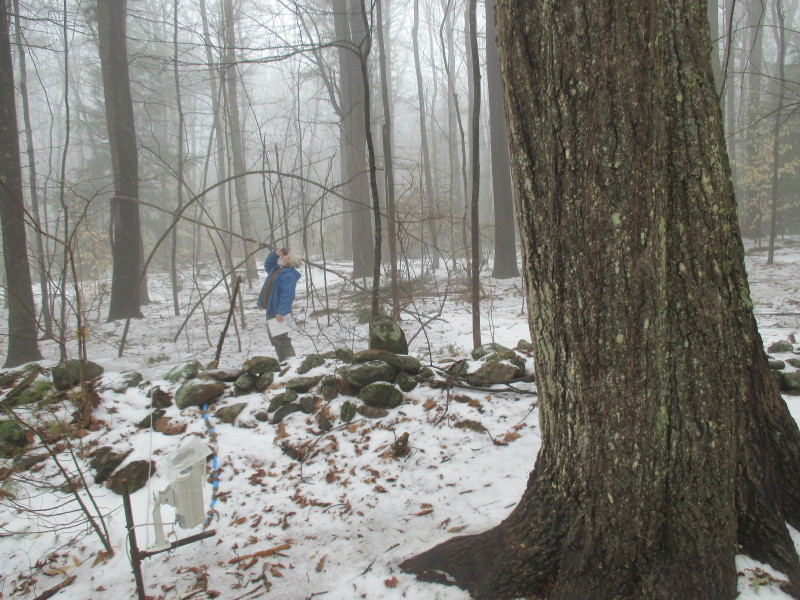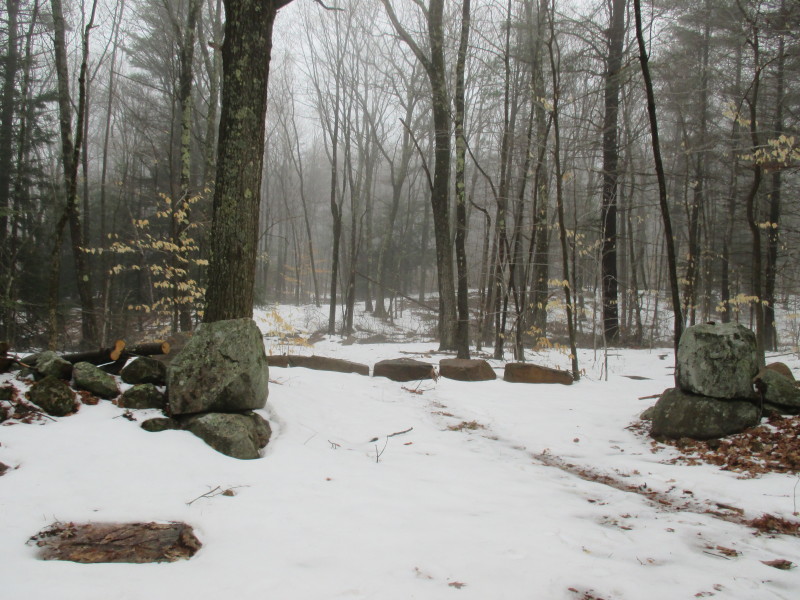WARM PLUS COLD EQUALS FOG

Warm air easing over the cold ground resulted in a soft silvery fog today as John and I went for our second tree survey for the season. John looks for any sign of buds swelling on trees near the big oak, foreground, that I am studying at the Harvard Forest for my book, Witness Tree.
Snow eating fog swaddles the forest today. A phenomenon of warm air riding over the cold ground and snow, the fog wraps the trees in ghostly white, and silently erases the snow with its warm breath.
But there is still plenty of snow left. Out today for a second tree survey of the new year, I measured snow a foot deep in lots of places. But for the first time, entire features of the landscape I hadn’t seen in months returned.
John O’Keefe, field phenologist for the Harvard Forest, began his spring tree survey this month. Every week until mid-June, he will walk a path through the same 50 trees he has watched go through their seasonal progression for 25 years. The result, as he makes notes, is a richly detailed record revealing the shifts in phenology, or seasonal timing in the era of global climate change. The variability year to year is dramatic, with the earliest spring on record just five years ago, while this may turn out to be the latest.

Rain today beautifully brought out the colors and texture in the bark of the big oak I am studying at the Harvard Forest.
We record the appearance of the trees as they bud and leaf, and whole lot more. I was struck today by the return of the landscape itself. The stonewalls are back. They had been missing from view for months, the colors lost to white, the shapes to deep drifts, humped like sleeping animals. The big surprise was the barrier of big boulders across a wagon road that I had been walking right over all winter, without even knowing it. The snow was that deep.

I walked right over this barrier of boulders all winter without even knowing it was there until today. It’s good to see the landscape again as the snow melts, especially the beautiful stone walls.
The physical changes we saw in the woods today, compared with last week, were dramatic. It’s always that way:I think there can’t be that much to experience that’s different in just one week, and then there is. The sounds of running water, deep puddles, mud, and the return of bare ground in some spots – leaves at last. Even the scent of the air has changed; it is full of the smell of earth and decomposition. But today in 50 trees we still saw only one bud – one! – with a tuft of leaves emerging, on a red elderberry. But it was a beautiful bud, fat, green, and alive. One striped maple showed cracks in its buds, and a few red maples showed a bit of swelling. That’s it.
But the vernal pool at the Hemlock Hollow was transformed with the first edges of open water. Drops of rainwater from the hemlock boughs overhead made silvery rings in the still water. It won’t be long now until the wood frogs emerge, and begin their urgent quacking chorus.

Open water in the vernal pool at Hemlock Hollow will soon draw chorusing wood frogs. Maybe even tonight if we have more warm rain.
I have my window open in the office as I write this, and the fragrance of spring keeps finding me. The movement of fog in the warm air as I look out to the forest is beautiful, winding through the trees. It is a day of gentle transition, full of promise. “Not a lot of change biologically,” John said as we headed back in to Shaler Hall from our walk. “But there’s a sense of a lot of change coming.”


Leave a Reply